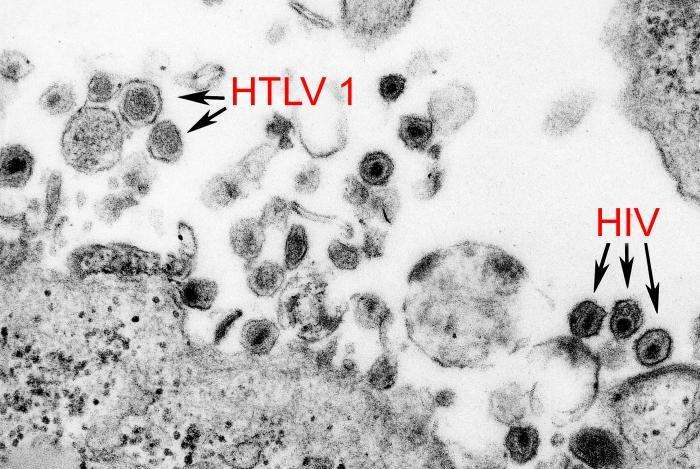This image revealed the presence of both the human T-cell leukemia type-1 virus (HTLV-1), (also known as the human T lymphotropic virus type-1 virus), and the human immunodeficiency virus (HIV). Human T-cell leukemia virus type-1 (HTLV-1), a human oncoretrovirus, is the etiologic agent of adult T-cell leukemia, and of tropical spastic paraparesis/HTLV-1–associated myelopathy. Two closely related retroviruses, HIV-1 and HIV-2, have been identified as causing AIDS in different geographic regions. HIV-1 causes most cases of AIDS in the U.S., with only a few cases of HIV-2 having been found in the U.S. Epidemiologically, HIV-2 has been found to be mostly an infection of persons from West Africa. Credit: Centers for Disease Control and Prevention's Public Health Image Library
At least one kind of virus has become less lethal when targeting a woman to ensure she does not die before it can infect her offspring, according to a study released Tuesday.
For years, scientists assumed that the HTLV-1 virus—which can cause leukaemia among other illnesses—was more deadly for men because women had a stronger immune system, at least for that particular bug.
But new evidence, published in the journal Nature Communications, shows the virus has adapted through evolution to take advantage of an opportunity that males cannot offer.
"The reason why these illnesses are less virulent in women is that the virus wants to be passed from mother to child," explained Vincent Jansen, co-author of the study and a professor at the University of London.
This can happen, he added, either at birth or during breast feeding.
As Charles Darwin discovered, the evolutionary strategies that creatures devise to attract mates or prey, or avoid getting eaten, are endlessly complex and surprising.
Exactly how viruses—microscopic particles that have relatively simply genetic material—can detect and adjust to the gender of the host they infect remains unknown.
But using complex mathematical models, Jansen and fellow University of London researcher Francisco Ubeda showed that no other explanation is nearly as plausible.
They compared the incidence and progression of HTLV-1 in Japan and the Caribbean.
In Japan, they found the virus was nearly three times more likely to graduate to deadly adult T-cell leukaemia in men than in women.
In the Caribbean, however, the chances of the virus mutating into its lethal form was roughly equal for both sexes.
The reason, they surmised, was a difference in how infants are reared.
Breastfeeding—one of the ways the virus can be passed from mother to infant—is more common and prolonged in Japan, "prompting the virus to become less fatal in women", they concluded.
A virus replicates only inside the living cells of other organisms, including plants, animals and bacteria.
Viral diseases range from the common cold to smallpox, hepatitis, dengue, Ebola, measles and AIDS. They kill millions of people every year.
More information: Nature Communications, nature.com/articles/doi:10.1038/ncomms13849
Journal information: Nature Communications
© 2016 AFP























